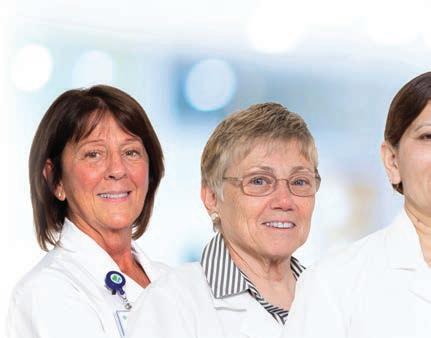
2 minute read
PREVENTING ESOPHAGEAL CANCER


A NEW TECHNOLOGY MAY HELP SAVE THE LIVES OF PATIENTS WITH CHRONIC HEARTBURN.
ABOUT 20 PERCENT of Americans experience heartburn at least twice a week, according to the American Society for Gastrointestinal Endoscopy (ASGE). Many have a serious condition called gastroesophageal refl ux disease, also known as GERD. Symptoms, which occur after eating, include burning in the chest, as well as a bitter or sour taste in the back of the throat. This occurs when the valve at the base of the esophagus, called the lower esophageal sphincter, relaxes too frequently, allowing stomach acid to rise into the esophagus. Treatment typically involves medication, which helps to reduce stomach acid and heal the irritated esophagus.
About 10 to 15 percent of people with GERD develop a precancerous condition called Barrett’s Esophagus (BE), in which the lining of the esophagus starts to resemble the cells of the small intestine. People with BE have a 30-fold increased risk of developing esophageal cancer, so they should be monitored with an upper endoscopy. With this procedure, a physician places a thin, fl exible tube into your mouth and esophagus to check for changes in the lining of the esophagus. This may be done every three to fi ve years, depending on a person’s risk factors for esophageal cancer, including family history, smoking and alcohol consumption. If the physician sees abnormal tissue, he or she can remove a sample of it, called a biopsy, to check for cancer.
A BETTER BIOPSY Traditionally, physicians have used tiny forceps to perform biopsies of esophageal tissue. Now, physicians at Holyoke Medical Center (HMC) are using a new technique that helps to improve the detection of precancerous cells. Called Wide Area Transepithelial Sampling (WATS)-3D, the technique involves using a probe with a brush on the end. The physician rotates the brush against the lining of the esophagus, and cells stick to it. The sample is sent to a lab, which uses computer-assisted analysis to create a three-dimensional image of the cells. This enables the pathologist to better identify precancerous cells. With the traditional biopsy method, the sample
From left: Jeanne McCarthy, PA-C; Mary Norris, MD; Ruby Malik, MD; April Bowers, NP; Jessica Sanky, FNP; and Tuyyab Hassan, MD


SURPRISING SIGNS OF CHRONIC HEARTBURN Symptoms of gastroesophageal refl ux disease, also known as GERD, can resemble other medical problems. Let your physician know if you experience any of the following: • Chest pain • Sinusitis • Asthma-like symptoms or an exacerbation of asthma • Ear infections • Vocal cord problems • Damage to teeth
is two-dimensional. Another advantage of WATS-3D: a wider area of tissue is sampled, which improves the odds of detecting precancerous tissue. With the traditional method, areas are randomly sampled, so spots can be missed. Currently, HMC physicians are using both biopsy methods. Esophageal cancer—which has a fi veyear survival rate of just 45 percent when the tumor is confi ned to the esophagus— can be diffi cult to detect. But the WATS3D technology has the potential to help prevent cancer, says Tuyyab Hassan, MD, a gastroenterologist at HMC. “If we remove precancerous tissue, we can help prevent cancer from developing, just like we can help prevent colon cancer by removing polyps,” he says.







